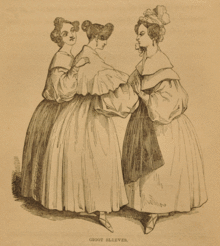Mary Philadelphia Merrifield
Mary Philadelphia Merrifield | |
|---|---|
 | |
| Born | Mary Philadelphia Watkins 15 April 1804 Brompton, England |
| Died | 4 January 1889 (aged 84) Stapleford, Cambridgeshire, England |
| Nationality | British |
| Occupation | Author & artist |
| Spouse | John Merrifield (c.1791-1877) |
| Children | 5, including Charles Watkins Merrifield and Frederick Merrifield. Other children Henry b.1830, Emily b.1835 & Edward b.1836 |
| Parent | Sir Charles Watkins |
| Relatives | Grand-daughters Margaret Verrall and Flora Merrifield |
Mary Philadelphia Merrifield (née Watkins; 15 April 1804 – 4 January 1889) was a British writer on art and fashion. She later became an algologist (an expert on seaweed).
Life[edit]
She was born Mary Philadelphia Watkins in Brompton, London in 1804. Her father, Sir Charles Watkins, was a barrister who specialised in transferring property ownership. In 1826/7, she married John Merrifield[1] and gave birth in 1827 to a son, Charles Watkins Merrifield, and a second son Frederick Merrifield in 1831.[2] They later moved to Dorset Gardens, Brighton. Her husband worked as a barrister and she undertook the translation of a book on painting by the 15th-century artist Cennino Cennini. The book, Treatise of Painting, was published in 1844.[1]
In 1846, she published The Art of Fresco Painting, which was a commission for the Royal Commission on the Fine Arts, being assisted by her two sons.[3] In 1850, she exhibited her paintings in the first art exhibition held in Brighton's Royal Pavilion.[4]

In 1854, she chose a different subject and published Dress as a Fine Art, which supported the more practical improvements of Amelia Bloomer.[1] Her approach challenged stereotypes, showing that fashion was a subject capable of scientific study. She demonstrated that people who were interested in fashion could aspire to academic interest.[5]

In 1857, she was showing her knowledge of local history when she published Brighton Past and Present.[6]
In 1857, she was honoured with a civil list pension of £100 per year.[1] She used her location at Brighton to research A Sketch of the Natural History of Brighton which, together with later scientific papers, made her an expert on seaweed.[3] In the 1870s she published more papers on natural history. She was so interested in corresponding with the naturalist Jacob Georg Agardh that she learnt Swedish.[6] Agardh returned the compliment by naming an Australian algae, Rytiphlaea Merrifieldiae (aka Nanopera merrifieldiae), after her.[7]
She continued to publish papers in the British scientific journal Nature. She also worked arranging natural history displays at Brighton Museum and Art Gallery.[3]
Death and legacy[edit]
Merrifield died a widow at her daughter's house in Stapleford on 4 January 1889. Her plant collections are now held by the Natural History Museum in London, with some examples in the Booth Museum of Natural History in Brighton.[3]Her son, Frederick, was later Chair of Brighton School of Art, while one of granddaughters Margaret Verrall became a classical scholar, and another, Flora Merrifield, was a campaigner for women's suffrage in Sussex.[8] Mary's work was the subject of a display in Brighton's Booth Museum of Natural History in 2019.
Works[edit]
- Treatise of Painting (translation) - 1844
- The Art of Fresco Painting - 1846
- Original Treatises on the Arts of Painting - 1849
- Practical Directions for Portrait Painting in Watercolours - 1851
- Dress as a Fine Art - 1854
- Handbook of Light and Shade with Reference to Model Drawing - 1855
- Brighton Past and Present - 1857
- A Sketch of the Natural History of Brighton - 1864
References[edit]
- ^ a b c d 'Mary Merrifield', Oxford Dictionary of National Biography, Retrieved 6 November 2015.
- ^ Adrian Rice, 'Merrifield, Charles Watkins (1827–1884)', Oxford Dictionary of National Biography, Oxford University Press, 2004; online edn, Jan 2012 accessed 8 Nov 2015
- ^ a b c d Mary Merrifield, Brighton Museums, Retrieved 6 November 2015
- ^ Loske, Alexandra (February 2019). "Brighton's very own colourwoman". Viva Brighton: 11–13.
- ^ Palmer, Caroline (January 2013). "Colour, Chemistry and Corsets: Mary Philadelphia Merrifield's Dress as a Fine Art". Costume. 47 (1): 3–27. doi:10.1179/0590887612Z.00000000012. ISSN 1749-6306.
- ^ a b Mary R. S. Creese (1 January 2000). Ladies in the Laboratory? American and British Women in Science, 1800-1900: A Survey of Their Contributions to Research. Scarecrow Press. p. 31. ISBN 978-0-585-27684-7.
- ^ Paul C. Silva; Philip W. Basson; Richard L. Moe (22 September 1996). Catalogue of the Benthic Marine Algae of the Indian Ocean. University of California Press. p. 551. ISBN 978-0-520-91581-7.
- ^ Elizabeth Crawford, The Women’s Suffrage Movement in Britain & Ireland: A Regional Survey, (Oxford & New York: Routledge, 2006), pp.205-206. ISBN 978-0415477390.
